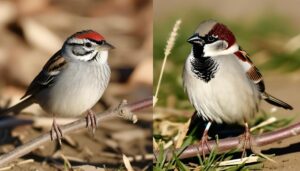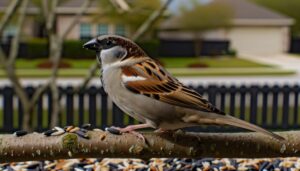How Do Sparrows Sleep in Trees at Night?
Sparrows sleep perched high in trees. They have a unique locking system in their feet that keeps them secure even while sleeping.
Their tail aides in maintaining balance and their sleep state, known as unihemispheric sleep, keeps them alert on one side, protecting them from predators. Their ability to conserve heat and maintain a lowered metabolic rate during sleep is an impressive environmental adaptation.
They face challenges like harsh weather and nocturnal predators, but roosting sites and group behaviour help mitigate these threats. This barely scratches the surface of these tiny birds' fascinating and complex survival strategies.

Key Takeaways
- Sparrows sleep perched in trees, using a complex locking mechanism in their feet for secure grip and stability.
- They utilize unihemispheric sleep patterns to stay alert to potential threats while resting, mainly during the first half of the night.
- Sparrows' sleeping posture, including head tilt and tail position, aids in conserving heat, reducing muscle strain, and signaling danger.
- They adapt to nighttime predators by high perching, camouflage, and group roosting, while also utilizing unihemispheric slow-wave sleep for threat response.
- The choice of roosting sites is crucial for sparrows as it provides shelter, helps regulate body temperature, and enhances safety from ground-based predators and birds of prey.
Sparrows' Unique Sleeping Habits
Despite their tiny size, sparrows exhibit a remarkable ability to sleep perched in trees, a peculiar habit that not only provides them safety from predators but also allows them to conserve energy.
This unique behavior is possible due to the bird's specialized physiology, including their locking mechanism in the feet which engages when they bend their legs, allowing them to grip onto the branch securely.
Importantly, this grip doesn't relax even during deep sleep phases, ensuring that the bird doesn't fall.
Moreover, the sparrow's sleep is characterized by minimal movement and a lowered metabolic rate.
This reduction in energy expenditure enables the sparrow to survive the night on limited resources, demonstrating a beautifully efficient adaptation to their environment.
The Mystery of Unihemispheric Sleep
The intriguing phenomenon of unihemispheric sleep, where one half of the brain is awake while the other half sleeps, is well-documented in various animal species.
Yet, it's the sparrows' utilization of this unusual sleep pattern that sparks considerable scientific curiosity.
This peculiar sleep mode not only allows sparrows to remain alert to potential threats, but also enables them to maintain their perch high up in trees during their nocturnal rest.
Unihemispheric Sleep Explained
One fascinating aspect of sparrows, and many birds in general, is their ability to engage in unihemispheric sleep, a mysterious process where one hemisphere of the brain stays awake while the other sleeps. This intriguing phenomenon allows them to maintain awareness of their surroundings, even while resting.
Scientific research shows that this form of sleep occurs mainly during the first half of the night, allowing the birds to remain vigilant for potential threats. The side of the brain that remains awake depends on the bird's position within the flock.
Those on the perimeter often keep the outward-facing hemisphere awake for monitoring purposes, revealing a surprising level of sophistication in avian sleep patterns. It's a survival strategy that's both efficient and complex.
Sparrows and Unihemispheric Sleep
In studying sparrows, scientists have uncovered a fascinating puzzle: these small birds employ unihemispheric sleep, a trick that seems almost magical in its complexity. Fundamentally, one half of the sparrow's brain stays awake while the other half rests. This allows them to maintain a degree of alertness even during sleep, an advantage that's truly invaluable in their vulnerable treetop roosts.
They've perfected a delicate dance of vigilance and rest, a balance that's sharpened by evolution for survival. Despite the relatively small size of their brains, sparrows have mastered an intricate system that even humans, with all our cognitive prowess, haven't evolved.
It's a demonstration of the adaptability of these tiny creatures, and a reminder that size doesn't always equate to complexity or capability.
Adapting to Nighttime Predators
Sparrows, like all creatures, face a myriad of predatory threats, especially during the vulnerability of sleep. Their survival tactics at night have evolved over time, adapting to these threats in innovative ways.
The evolution of their sleep habits, in particular, offers fascinating insights into how they manage to thrive despite these nocturnal challenges.
Sparrows' Predatory Threats
Night's cloak of darkness brings with it a host of predatory threats that sparrows must skillfully navigate to survive. Owls, cats, and snakes are among the predators that pose a significant risk. However, each predator presents its own unique set of challenges, requiring sparrows to adapt and respond differently.
Below is a table that breaks down the predatory threats sparrows face:
| Predator | Threat Level |
|---|---|
| Owl | High |
| Cat | Medium |
| Snake | Low |
Owls, being nocturnal and airborne, present the highest threat level. Cats, though formidable, are less of a risk due to their primarily terrestrial hunting methods. Snakes, while capable of climbing trees, are generally slower and less frequent predators of sparrows.
Nighttime Survival Tactics
Wandering the perils of the night, sparrows employ a range of ingenious survival tactics to outwit their nocturnal predators. They've adapted to use a four-pronged approach:
- Camouflage: Sparrows' muted brown and grey feathers blend seamlessly with the tree bark, rendering them virtually invisible to predators.
- Group Roosting: They often sleep in large groups, confusing predators and reducing individual risk.
- High Perching: By choosing to sleep high in the trees, sparrows place a considerable distance between themselves and ground-dwelling predators.
- Vigilance: Even in sleep, they remain alert, ready to take flight at the slightest sign of danger.
These tactics reveal the sparrows' astute understanding of their environment and threats, ensuring their survival night after night.
Evolution of Sleep Habits
While these ingenious survival tactics reflect sparrows' current nighttime behavior, it's their evolutionary journey that has shaped these sleep habits, enabling them to adeptly avoid nocturnal predators.
As species evolved, birds developed unihemispheric slow-wave sleep (USWS), allowing one half of their brain to sleep while the other remains alert. This adaptation is critical for sparrows, who can respond to threats even while at rest.
Their propensity to perch high in trees also evolved as a means of protection, reducing their visibility to ground predators. It's this blend of physiological and behavioral evolution that has equipped sparrows to thrive in their nighttime environment.
These adaptations highlight the complexity and effectiveness of nature's survival strategies, underscoring the intricate interplay between evolution and environment.
The Role of Tail Positioning
In the quiet darkness, a sparrow's tail positioning plays an important role in its ability to maintain balance while sleeping in trees. The tail acts like a rudder, keeping the bird steady even on a windy night.
Equilibrium: The tail feathers spread out, creating a wider base that helps the bird maintain stability.
Hold: The tail presses against the branch, creating friction which assists in retaining a secure grip.
Protection: Drooping the tail covers the feet, offering insulation from cold.
Warning: A raised tail can alert other sparrows to potential danger.
In essence, tail positioning is an intricate system that sparrows have adapted for survival. It's a demonstration of their resilience and ingenious biological design.
Perching: Sparrows' Sleeping Posture
Perched delicately on their chosen branch, sparrows adopt a unique sleeping posture that combines efficiency, safety, and comfort. Their stance is the epitome of balance; each bird positions itself on one leg, tucking the other close to its body. This not only conserves heat but also reduces muscle strain.
The head tilts back, nestling snugly in the feathers on the back. This posture keeps them alert to their surroundings.
Their feet play a vital role. These little creatures grip onto the branch tightly, a hold that's actually strengthened during sleep due to a complex tendon mechanism. This, in turn, ensures they won't fall, even amid winds.
Sparrows' sleeping posture is an intricate interplay of biology and behavior that maximizes rest while minimizing vulnerability.
Sparrows and Weather Challenges
Despite their adept sleeping posture, sparrows still face the formidable challenge of weather conditions.
- Rain: Sparrows can't sleep well in heavy rain. Their feathers may get soaked, making it harder for them to maintain the balance needed for a peaceful snooze.
- Cold: Extreme cold can be detrimental. Sparrows fluff up their feathers to trap body heat but severe cold might still pose a risk.
- Wind: Strong winds can displace sparrows from their perch. They grip tighter to their branch to prevent falling.
- Heat: Overheating can lead to dehydration for sparrows, especially in summer.
These challenges show how even a simple task like sleeping can be a battle against nature for these small creatures.
The Importance of Roosting Sites
Securing a safe and comfortable roosting site plays a pivotal role in a sparrow's nightly routine, directly impacting their ability to ward off predators, endure harsh weather conditions, and get adequate rest. These sites, often nestled in dense foliage or hollowed out tree trunks, provide a much-needed shelter from the elements. They're essential in maintaining the bird's body temperature, especially during winter months.
The positioning of these roosts also matters. A higher location can offer protection from ground-based predators, while a concealed one deters birds of prey. Additionally, roosting in groups can enhance warmth and safety, making a well-chosen site a social hotspot.
Therefore, the importance of a proper roosting site can't be overstated; it's integral to the sparrow's survival and well-being.
Conclusion
In the hush of twilight, sparrows tuck themselves into nature's leafy bedrooms, perching tightly on their arboreal bunks. Their unique unihemispheric sleep and tail positioning befit the night and its predators, transforming them into feathered sentinels.
Weather's harsh hands may rattle their roosts, yet these diminutive warriors remain resilient. Roosting sites echo the importance of community in their survival, painting a vivid picture of their nocturnal lives.
Truly, sparrows' sleep is a ballet of survival, adaptation, and resilience.






